 A girl and a boy hugging and kissing their mothers belly in anticipation of the sibling that is inside.
A girl and a boy hugging and kissing their mothers belly in anticipation of the sibling that is inside.
Friday, December 19, 2008
Waiting for the Baby ...
 A girl and a boy hugging and kissing their mothers belly in anticipation of the sibling that is inside.
A girl and a boy hugging and kissing their mothers belly in anticipation of the sibling that is inside.
Tuesday, December 16, 2008
Rant: October 2008 Mac Book [Pro] Screen and Keyboard
1. The glossy display is hard to see under the best of conditions. With only moderate levels of ambient light it turns into a mirror reflecting all kinds of things instead of showing what I want to see on screen. There is also the problem that glossy screens are much worse in a color calibrated environment due to color shifts with the viewing angle. Unfortunately, there is no option to select a non-glossy screen.
2. The keyboard is a piece of junk. Sorry for the blunt words, but fast touch typing is simply not possible on what feels like the cheapest and nastiest keyboard I have touched in years. A $5 keyboard bought at the supermarket is better than this.
So for my two most important applications, digital photo editing and typing text, the new Mac Book Pro is much worse than what I currently have, so I will refrain from updating and Apple looses the sale.
I hope that despite the strong words about the keyboard Apple take this as positive criticism and - perhaps - improve their product. I really would like to buy a new Mac Book Pro once I can justify the purchase. ;-)
Tuesday, December 2, 2008
Book Review: Mastering Landscape Photography
So I was quite excited when I saw that Alain Briot has authored a book on his way of photographing landscapes.
Sunday, November 23, 2008
Book Review: face to face
Rick starts by explaining that the camera looks both ways, which means that there is always an emotional connection (or lack thereof) between the photographer and his or her subject. This connection is at least as important as the technical aspects of taking the photo, since it determines the content. I believe that it is far too common for photographers to become far too focused on the technical aspects of photography instead of the content, so I like being reminded of this simple fact.
Thursday, November 20, 2008
Mountains and Contrails
[caption id="" align="aligncenter" width="600" caption="Mountains and Contrails"]
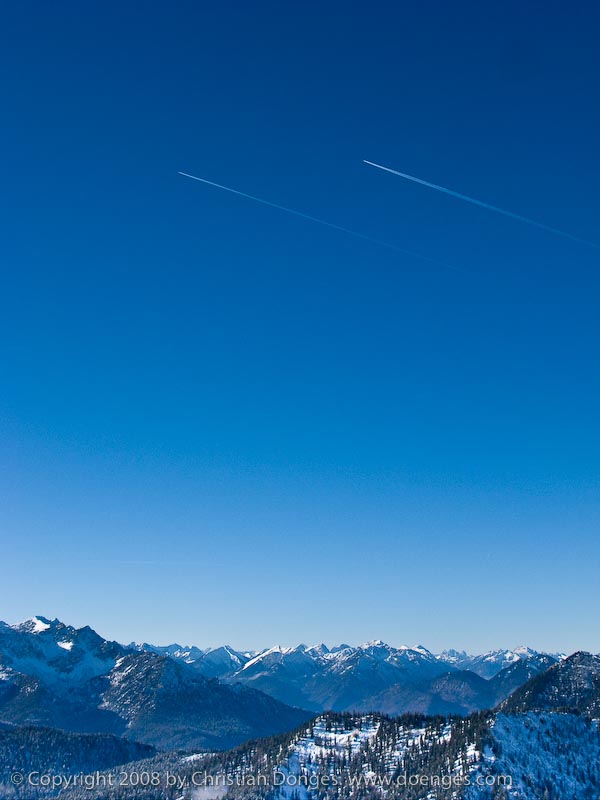 [/caption]
[/caption]
Wednesday, November 19, 2008
Ice Crystals
Close to the ground the snow crystals on the pines created a wonderfully sculpted landscape.
[caption id="" align="aligncenter" width="800" caption="Snow Crystals V"]
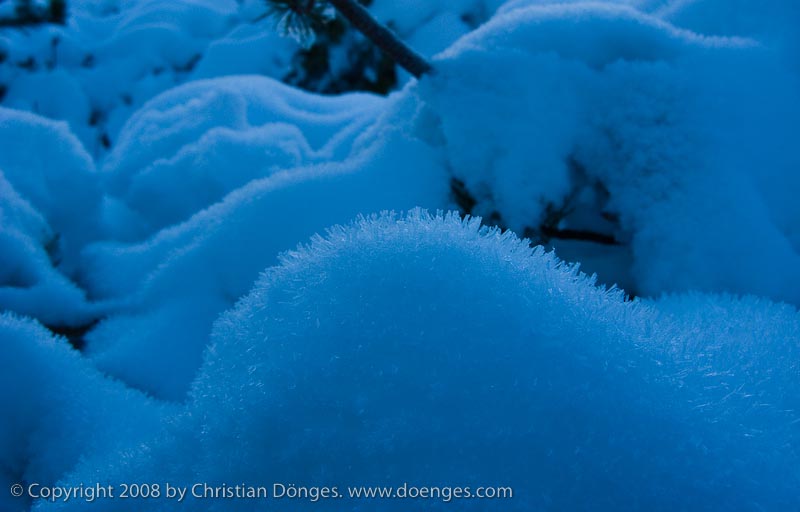 [/caption]
[/caption]The blue tinge is caused by ice filtering light as it passes through or is reflected. I decided not to correct it because I quite like the effect.
Alpine Panorama
Image quality is a compromise, of course, but more than good enough for web use or up to medium print size. Sometimes, it is better to have a good time than to get the ultimate in image quality. ;-)
[caption id="" align="aligncenter" width="800" caption="Alpine Panorama XV"]
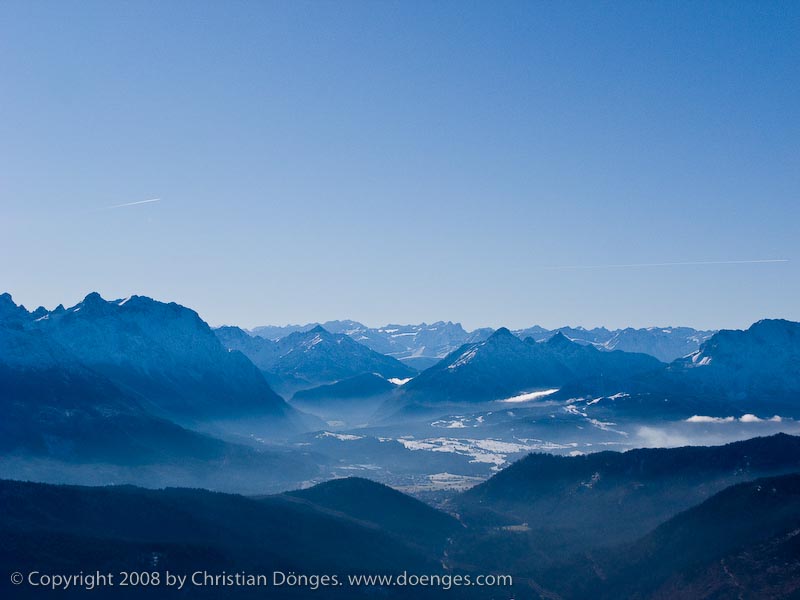 [/caption]
[/caption]
Friday, November 14, 2008
Book Review: Mastering Digital Black and White
Mastering Digital Black and White by Amadou Diallo covers a lot of ground, but it focusses completely on digital black and white photography. In fact, it is the most comprehensive book on the subject that I have found to date. What a pleasant surprise!
Wednesday, October 29, 2008
Frog on a Rock
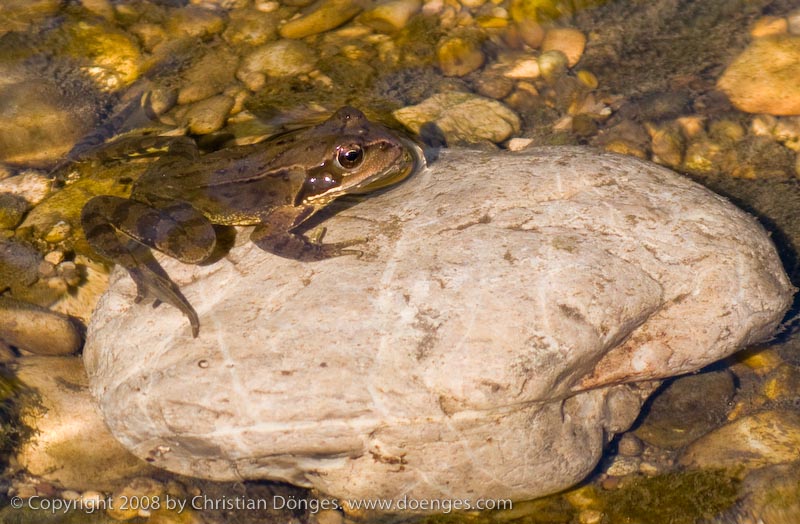
I like the way the shape of the rock mimics the shape of the frog - or is it the other way around?
Friday, October 17, 2008
Dragonfly on a Rosebud
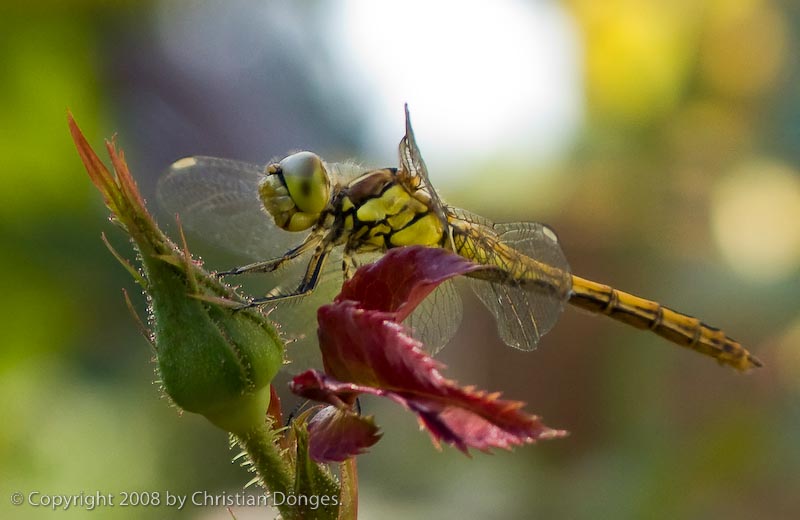
Unfortunately I did not have time to grab my DSLR - fortunately I had the G9 ready in a pocket and managed to squeeze off a few shots before I had to run. I am rather pleased with the depth-of-field (or lack thereof) from such a small sensor.
Sunday, October 12, 2008
Honey Bee on a Yellow Flower
[caption id="" align="aligncenter" caption="Honey Bee on Yellow Flower"]
 [/caption]
[/caption]I took this picture using an extension tube and a tripod. The problem with this setup was that the area in which the image was sharp was about 3-4 mm in depth and there was a breeze blowing. The swaying of the flower made it go in and out of focus, so I lost quite a number of interesting pictures due to lack of sharpness.
Does anyone have an idea what the name of the flower is?
Sunday, October 5, 2008
Book Review: Picture This - How Pictures Work
This is certainly the book that has surprised me most this year! Molly Bang uses four differently colored papers and cuts out shapes from them to make images. I was fascinated to see how simple shapes cut from paper can have such a powerful emotional impact. The woman is clearly a master.
Friday, September 12, 2008
Email Security Is Hard
a partnership between the Department of Homeland Security and the public and private sectors. Established in 2003 to protect the nation's Internet infrastructure, US-CERT coordinates defense against and responses to cyber attacks across the nation.
http://www.us-cert.gov/aboutus.html
This is an organization created that I would expect to be on top of security-related issues. And it would seem, at first glance, that these people do know their stuff:
Saturday, September 6, 2008
Red Admiral
[caption id="" align="aligncenter" width="640" caption="Red Admiral on the Rocks"]
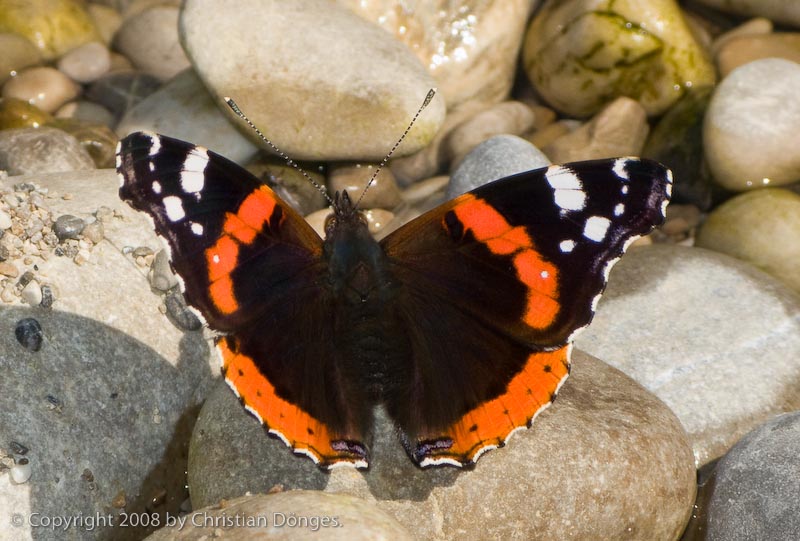 [/caption]
[/caption]
Mountain Photos
[caption id="" align="aligncenter" caption="Mountain IV"]
 [/caption]
[/caption][caption id="" align="aligncenter" caption="Mountains XIX"]
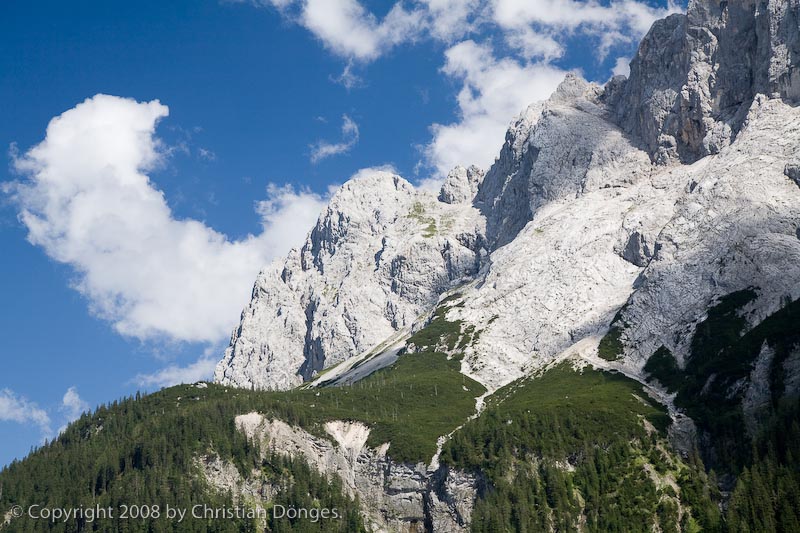 [/caption]
[/caption][caption id="" align="aligncenter" caption="Glacier in the Fog"]
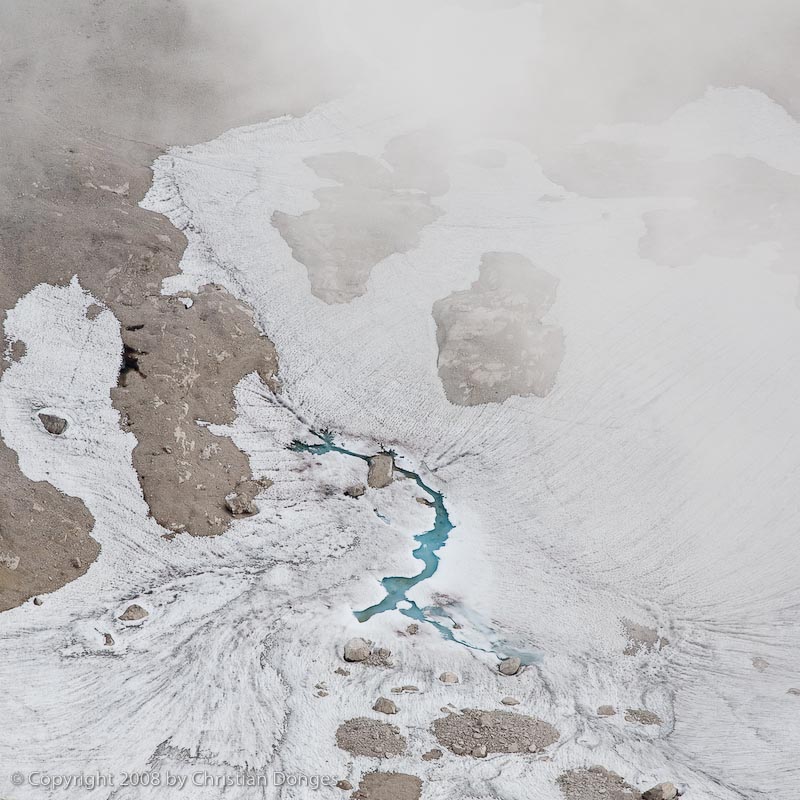 [/caption]
[/caption]You can find more mountain images in the gallery.
In case you are wondering: no, the photos where not all taken in the same location or even on the same trip. ;-)
[ad#end-of-post]
Monday, August 11, 2008
Cactus Flower
 [/caption]
[/caption]Early in the morning I saw that one of the cacti on my window sill had started to grow a long appendage carrying a flower bud. By about 8 p.m. the bud started opening up.
Around midnight the flower was in full bloom with delicate pink petals spread wide to allow some desert insect to spread pollen and repeat the circle of life. Sadly, that would not happen on my window sil. :(
By the next morning the flower had wilted away again.
Sunday, August 10, 2008
Book Review: Digital Macro Photography by Ross Hoddinott
The second chapter introduces various lenses, tripods, flash units, and other accessories useful for macro photography.
Friday, August 8, 2008
Nikon Coolpix P6000
But then I read this:
COOLPIX Picture Control NRW (RAW) files can only be processed in-camera. NRW (RAW) files are compatible for use in-camera, with ViewNX (Windows version only) or with WIC based applications. Capture NX, Capture NX2 and NEF files are not compatible with NRW (RAW) images.
WIC is Windows Imaging Component, a Microsoft API for Microsoft Windows. In other words: converting RAW files to something else can happen only in camera or on MS Windows.
So what does that mean? Not only does Nikon introduce yet another completely useless RAW format (how hard is it to realize that DNG is the present wave and certainly the future?) they clearly think that Mac users are not to be customers of their fine camera.
It strikes me that Nikon seem to be unable to understand a fundamental fact: as a photographer I want full control over my image files. That is one reason I shoot RAW. I do not want encrypted data in the file. I do not want strange and proprietary formats that reduce my software choices and leave me high and dry in a few years when the special software no longer runs on whatever computer I will have.
I do want an open, fully documented format - such as DNG. Simple as that.
So Nikon, you are quite welcome to spend lots of money on advertising this wonderful new camera, but I will not buy it. Too bad, it seems like a really nice camera that would be very tempting otherwise.
Update: At least Adobe know their stuff and Adobe Camera Raw can now read the raw files from the P6000. Nikon still don't seem to get it ... read the review by Thom Hogan for the entire depressing story.
Wednesday, July 16, 2008
Using Lightroom and Expression Media to Modify Metadata
My specific question is regarding how you were able to use both LR and XM2. Did you upgrade from iVMP and added LR into your Workflow after it got released?
I used iVMP before, but am exclusively using LR. However, being frustrated with its DAM capabilities, i am looking to go back to XM2. Were you able to migrate your LR catalogs to XM2? Any thoughts welcome. Thanks in advance.
I understand the frustration with the DAM (Digital Asset Management) capabilities of Adobe Lightroom - looking at both Bridge and Lightroom I sometimes feel that Adobe just don't get DAM. But there is always hope for LR2. ;-)
I have Lightroom and Expression Media working together nicely (see here ). The way that works for me is to write the metadata changes I make in Lightroom directly to the image files instead of to XMP sidecar files. This works well with JPEGs and DNGs.
XM can import the metadata changes (you have to initiate this manually).
If you simply want to go one way from Lightroom to Expression Media you are done at this point.
If you want to work with both programs you then write the changes you make in Expression Media to the files (manual command). Lightroom can import the change and you can continue editing in Lightroom.
This way of working is not perfect because it requires that you to remember to manually sync, but it seems to preserve all the data.
Sunday, May 25, 2008
Backup Strategies for Photographers
In the "good" old days of film, the problem was keeping the materials, i.e. negatives and prints, safe from harm (fire, flood, mildew, theft, etc.) and in pristine condition. The latter could be a problem if the materials where not of archival quality or contaminated or whatever.
As "digital" photographers our assets are by nature primarily digital files. The advantage of digital files compared to negatives or prints is that the problems associated with those are easily mitigated or can not occur because of the different nature: keeping a digital file safe from harm is easy is enough copies are kept in enough different physical locations. And deterioration is also not a problem for digital files.
There are, however, a number of risks and issues specific to digital files:
- All currently available media deteriorate over time.
- Files may suffer from "bit rot", usually through copying errors or because of media deterioration.
- Hardware becomes obsolete and it may not be possible to use todays media in 10 or 20 years because the physical connectors are no longer supported, because there are no drivers, or because hardware can not be replaced if it fails.
- File formats become obsolete and are no longer supported.
Let's look at the specific problems.
Media Deterioration
An old quib is that it is not a question wether a hard drive will crash but when. Hard drives are mechanical devices, so it is just a matter of time until they wear out or dust gets inside or something else goes wrong. And if you think that keeping the hard drive in a cool, dark place will help I have to disappoint you: the lubricants deteriorate and eventually the hard drive will fail. In fact, a drive that is spun up regularly (every few weeks) will last much longer than a drive that is just kept in storage.
Optical media, such as CDs and DVDs will deteriorate quickly if not stored perfectly. And even if they are stored under perfect archival conditions, there is ample evidence that the expected data retention time is much, much lower than the time claimed by manufacturers. A friend of mine, for example, found that after 5 years 20-50% of his burned CDs and DVDs show one or more errors that can not be corrected.
Magneto-Optical (MO) media where guaranteed for 30 years and it seems that these claims where accurate. Unfortunately, this is obsolete technology and the drives are no longer being made.
Ultra density optical (UDO) media are interesting, with manufacturers guaranteeing 50+ years of data retention.The drives start at about USD 1000, media are about USD 2 per GB, so UDO is not cheap. This may still be a viable option if the data is valuable enough.
Solid state memory, i.e. flash, is usually able to retain data for 10 years. After that, all bets are off.
There is, of course, an easy way to deal with these issues: copy to a new medium regularly. Regularly means that you must guarantee that a copy (better: two) is created well before errors can be expected.
Bit Rot
Data may change as the medium it is stored on deteriorates. Data can also change due to copying errors.
There are various techniques to detect and correct bit rot. They all involve checksums and error correction codes to correct problems.
Hardware Obsolecence
Hardware becomes obsolete with time. Do you still have a ZIP drive to read ZIP media? If you do, does it work with your current computer? And what happens when the drive breaks and you need a new one?
It is relatively easy to protect against this if you copy to a new medium (that is going to be supported for a number of years) regularly.
Format Obsolecence
If you have data stored in a proprietary format, chances are that you have experienced this problem already. It seems that every new version of Microsoft Word, for example, seems to introduce subtle differences in the way old documents look.
Data stored in an open format, preferably with one or more open source implementations for reading and writing the format, is much safer from becoming obsolete. It seems that JPEG and TIFF, for example, will be around for a very long time, if not forever.
So how does this translate into a viable strategy for keeping my digital assets safe for a long time?
First off, I keep all my data in open formats. For digital negatives, I use DNG files with XMP metadata. Processed files are stored as TIFF. I must admit that I sometimes also use PSD (Adobe Photoshop), which is proprietary and not open, but only to store working copies, which really only make sense in Photoshop anyways.
I then calculate an MD5 hash over each file which is stored with the file. This way I can easily detect changes to the file.
The files are stored on multiple hard drives. I use a combination of FireWire and USB external drives and internal drives that are quickly swapped using a Sharkoon SATA QuickPort which is a docking bay allowing a SATA drive to be connected to a USB port.
The drives containing multiple copies of the files are stored at home, in the office, and offsite (bank vault, friend's house, etc.).
I have a regular calendar task to check the hashes on every drive every few months. If a single error is found on a drive the entire drive is tossed. This is not a problem as long as there is still a good copy on a different drive. The integrity check has the added benefit of ensuring that the lubricants of the drive get a good workout.
There is another calendar task to replace every drive after it is 3 years old. With the inevitable march of technology increasing the capacity of hard drives, I can consolidate the content of two old drives on a single new drive.
This strategy is probably not perfect, but it does give me a high degree of confidence that the files will still be useable in the distant future.
Canon G9 at 8 MP
If you were to switch G9 to a next-down image size (8MP, no?) would it improve a quality of an image?
(...)
Would this work in the same camera (the G9) if you merely changed the settings? Would ISO400 look more like ISO 200? Could ISO 800 be used at all? How does it all compare to A2?
Interesting question!
Wednesday, May 21, 2008
Voltcraft K204 Datalogger on Mac OS X
The logger allows you to capture up to 16,000 samples from up to four different K-Type temperature probes. Depending on the probes, a temperature range of -200°C (-328°F) to 1370°C (2498°F) may be covered with a 0.1°C resolution.
The K204 sports a serial port and comes with a RS232 cable. No Macintosh computer has come with a RS232 port for the last ... what ... decade or so?
Saturday, May 10, 2008
Comparing the 2004 Konica Minolta A2 with the 2007 Canon G9
Thursday, May 8, 2008
India
I was (and still am) fascinated by the colors, the smells, the bustling business everywhere. The general feel was of vibrant aliveness.
Because my primary objective was not photography, I decided to carry only a Canon G9, not a DSLR. I figured that because of the generally intense sunlight, I would not have to do much high-ISO shooting, so image quality would be acceptable. I also figured that I would deeply regret the shots that I would loose because of this decision.
Well, I was right on both counts. Most pictures were taken in sunlight so bright that sensor density (i.e. the number of f-stops between the highest and lowest levels of light that can be discerned) was the limiting factor, not sensor sensitivity.
And I lost a number of shots because the G9 is so much slower than a DSLR. Try riding in a 3-wheeler cab through dense urban traffic with the driver going like the devil is breathing down his back and then you see an elephant in the fray ... by the time the autofocus had gained focus, we were well and truly on a different street.
I am still rather pleased with the results and in all honesty, since the G9 was just small enough for me to have it with me literally all the time, I probably got some shots that I would not have gotten with a DSLR because the bigger camera would have been in the hotel room or in a bag.
Decide for yourself what you think, there are more images in this gallery!
[caption id="" align="aligncenter" width="640" caption="Boy flying a kite"]
 [/caption]
[/caption][caption id="" align="aligncenter" width="800" caption="Oxcart delivering ice"]
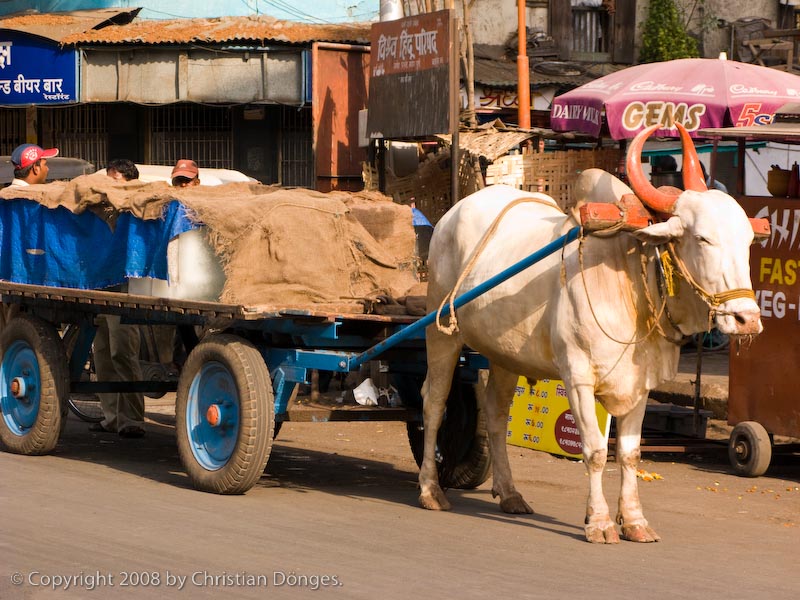 [/caption]
[/caption][caption id="" align="aligncenter" width="640" caption="Shrine to an unknown deity"]
 [/caption]
[/caption]
Saturday, February 23, 2008
Wild Geese in the Sunrise Sky
[caption id="" align="aligncenter" width="800" caption="Wild Geese in the Sunrise Sky"]
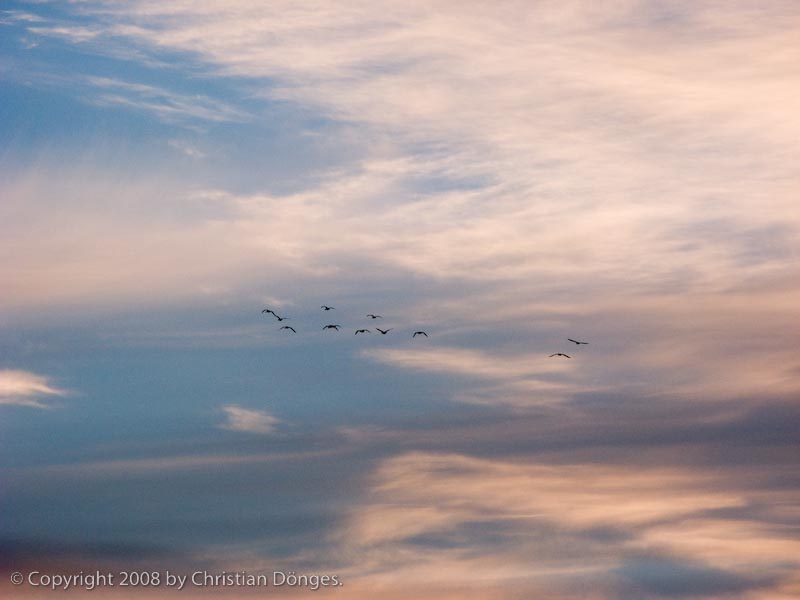 [/caption]
[/caption]
Saturday, February 16, 2008
Morning Geese
A little bit later than Morning Cranes as the sun just began to rise, the first golden beams hit the edge of the forest just as two wild geese landed on the water.
[caption id="" align="aligncenter" width="640" caption="Morning Geese"]
 [/caption]
[/caption]
Morning Cranes
Early in the morning I captured some cranes before sunrise. I love the light airy quality of the pre-sunrise colors. Note the frost on the gras and the way it captures the light.
There is considerable sensor noise from the G9 I used to take the picture. I decided to leave the noise artifacts intact because I like the grainy look which I think underlines the misty, slightly foggy quality of that morning.
[caption id="" align="aligncenter" width="640" caption="Morning Cranes"]
 [/caption]
[/caption]
Sunday, February 10, 2008
Gras in the Wind
While taking a walk, I noticed some gras swaying in the wind. It was amazingly hard to capture what I was looking for - one or two stalks perfectly in focus and the others blurred either because of motion or because of depth of field issues.
The depth of field for the lens at aperture 2.8 was minimal at the given distance. This was intended to achieve the desired effect, but it had the consequence that the swaying of the grasses in the wind made it almost impossible to focus. So I pre-focused and tried to capture the stalks as they passed through the plane of focus.
[caption id="" align="aligncenter" width="640" caption="Gras in the Wind"]
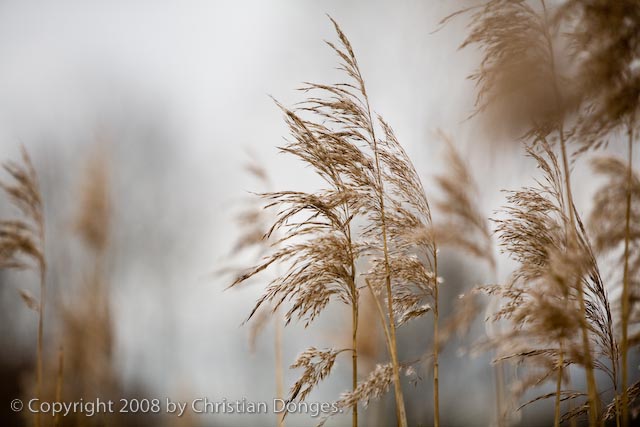 [/caption]
[/caption]The image is not exactly what I was looking for, but it is pretty close.
Saturday, January 19, 2008
Rocks and Ice
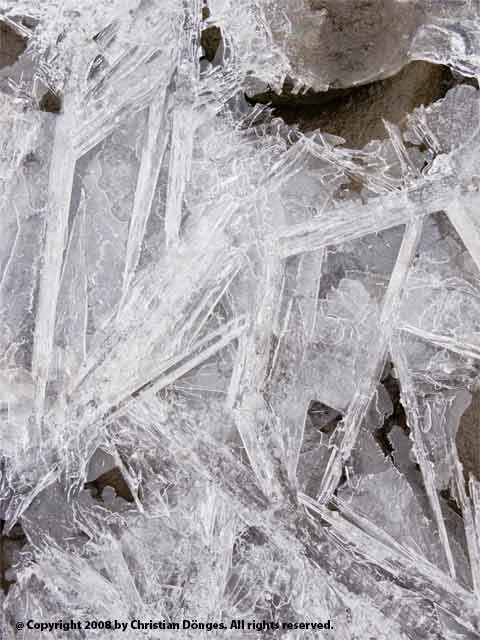
Here is what the image looks like after some mild editing:
[caption id="" align="aligncenter" width="480" caption="Rocks and Ice XXI"]
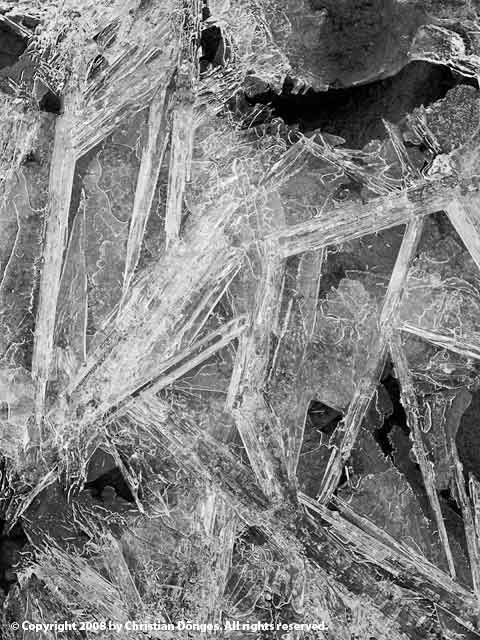 [/caption]
[/caption]The web version looks pretty good, but I am still not entirely happy with the way the prints for this series are turning out. The prints lack the final bit of "punch" that I'm looking for. I think a lot more time in Photoshop is called for ...Â